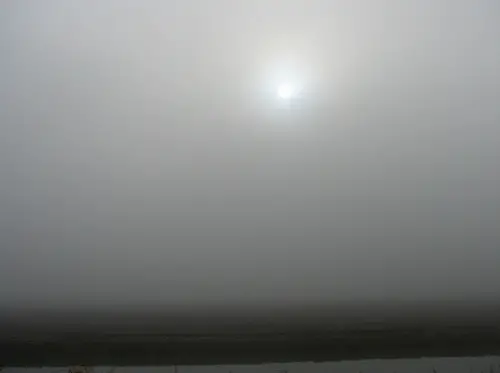Fog is caused by a supersaturation of the air so that it can no longer hold water vapor. This is a meteorological phenomenon where water vapor precipitates out into small droplets of fog or condensation. The process of fog formation is similar to that of cloud formation. Fog forms close to the ground rather than higher up in the atmosphere and can muffle or distort sounds as well as severely limiting visibility. These conditions are what often lead to traffic accidents during foggy weather.
When air reaches a point of extremely high humidity, fog will form. Usually a rapid cooling of the air will cause condensation to form. There are actually a variety of different types of fog that get their names from the conditions that they develop under. A light shone directly at fog will reflect and create glare. Drivers will often use low beams or fog lights to help them see in such conditions.
Advection fog is common along shores of oceans and large bodies of water. This type of fog occurs when moist air from the water passes over the cooler land surface. Often warmer inland air will suck the moist air across the land and create a thick band of fog. Advection fog is particularly common near the ocean because salt increases humidity meaning that condensation can form at a much lower humidity around salt.
Radiation fog is also common and will occur after dark when the Earth radiates heat outwards. As heat rises it will cool causing saturation conditions and fog. This type of fog will usually cling very close to the ground and disappear by mid-morning. The warmth of the day will dissipate it. Tule fog is a variation of radiation fog. Tule can be found in the Central Valley of California and is created when cold mountain air sinks into a depression such as the valley during nighttime. Warmer air from above will press down on the colder air below causing a fog to develop that can linger for days. This type of fog will occur during fall and winter when mountain conditions are colder.
There is a rare type of fog called ice fog that can only form in regions such as the Arctic and Antarctic. Ambient air temperature must be significantly below the freezing point, but still humid, and water droplets that would normally turn to fog then turn into small ice crystals instead. Ice fog can be extremely hazardous to drive in because the crystals will cling to windshields and headlights.
When air reaches a point of extremely high humidity, fog will form. Usually a rapid cooling of the air will cause condensation to form. There are actually a variety of different types of fog that get their names from the conditions that they develop under. A light shone directly at fog will reflect and create glare. Drivers will often use low beams or fog lights to help them see in such conditions.
Advection fog is common along shores of oceans and large bodies of water. This type of fog occurs when moist air from the water passes over the cooler land surface. Often warmer inland air will suck the moist air across the land and create a thick band of fog. Advection fog is particularly common near the ocean because salt increases humidity meaning that condensation can form at a much lower humidity around salt.
Radiation fog is also common and will occur after dark when the Earth radiates heat outwards. As heat rises it will cool causing saturation conditions and fog. This type of fog will usually cling very close to the ground and disappear by mid-morning. The warmth of the day will dissipate it. Tule fog is a variation of radiation fog. Tule can be found in the Central Valley of California and is created when cold mountain air sinks into a depression such as the valley during nighttime. Warmer air from above will press down on the colder air below causing a fog to develop that can linger for days. This type of fog will occur during fall and winter when mountain conditions are colder.
There is a rare type of fog called ice fog that can only form in regions such as the Arctic and Antarctic. Ambient air temperature must be significantly below the freezing point, but still humid, and water droplets that would normally turn to fog then turn into small ice crystals instead. Ice fog can be extremely hazardous to drive in because the crystals will cling to windshields and headlights.

